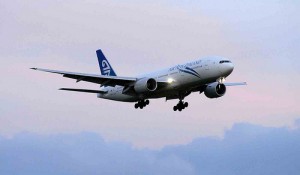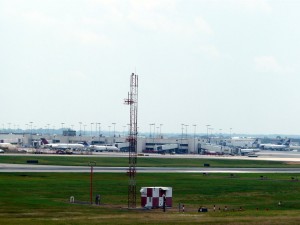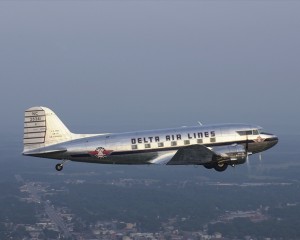
Air New Zealand Boeing 777 at Auckland, New Zealand
The idea of being able to access the internet on a flight is almost not newsworthy anymore, since it is so common (I love that). But a recent press release from Air New Zealand did catch my interest.
The airline will offer mobile phone and data capabilities with new Boeing 777-300’s to be delivered in November. In connection with AeroMobile, passengers will be able to text message and email on GSM phones. You will not be able to talk on your cell phone (thank goodness) and Air New Zealand does not plan to allow it. AeroMobile does have the ability to allow passengers to talk, but Air New Zealand decided not to offer that service (thank you).
’œFeedback from our customers has shown they wish to be able to text, and check emails, to stay in touch with friends, family and colleagues during their long-haul flights,’ said Ed Sims, Air New Zealand Group General Manager, International Airline.
You will still have to wait until you reach cruising altitude and your phone must remain on silent mode (good thinking). There is no additional fee except for standard roaming and text charges. Don’t go texting like crazy on your seven hour flight until you confirm your cell phone’s international roaming plan.
How does this work? AeroMobile installs a small base station (called a Picocell) on the aircraft, which relates data on board the airplane to a satellite, then back down to the ground. since there is very little needed to install the Picocell, there is no downtime for the aircraft, since it can be installed during normal maintenance.
Another great step towards being fully connected, even while flying!
Image: MJField

Can you find all 16 US Airways tails in this photo? (there is a bigger version in the links). Photo by Drew V.
Last week I put the challenge out to find photos with lots of airline tails. When I put the photos of a bunch of Qantas Airline’s tails, I only saw nine. However a reader smartly pointed out that there are really ten. Here are the photos I was sent:
* My original Qantas with TEN tails
* 10 Delta Air Lines tails from Daniel
* Aireal shot of 20 Delta tails from Daniel
* Who wants to count all these tails up? from Daniel
* 16 US Airways tails (with markings showing all 16) from Drew V
* 40 FedEx tails sent in from Rowen
* Five Qantas Airlines Boeing 747 tails at LAX by daeguowl
* A whole load of old US Airways Shuttle photos (even though I said Mojave wouldn’t work, but I can break my own rules) by @FlyInsider
* 12 Lufthansa tails from @FlyInsider
* Go ahead and count them in this satellite shot of Mojave forwarded by @BinkyAirways
* I count 15 Northwest Airlines tails, which will soon be going away – from @TerminalWanderer
So who is the winner? That is hard to tell since I am not counting them for all the photos. I will say EVERYONE is a winner for finding such great photos.
UPDATE: I have added a few more photos. It is not too late to send them on in to me, if you want them posted.

Some of the snacking goodness you will find in the box! Photo from Clint @ Horizon -- Thanks!
I love watching TV on the internet. I don’t even have cable anymore. Yea I still have to sit through a few advertisements, but totally worth it to get 100% free online shows. There have been many instances where looking at ads get you free stuff. Now Horizon Airlines and Air Advertainment are bringing a limited number of passengers free food!
On May 24th passengers on Horizon Air flight 2631 from Seattle to Portland were able to experience the first free food. The first test is being sponsored by Creative Labs, which is promoting a Facebook contest to name a new video camera. The boxes include a variety of snacks and over the next 20 days some 25,000 boxes will be handed out to Horizon passengers.
’œWith certain airlines cutting services and adding charges, this program is a welcome addition for passengers and operators alike,’ said Mary L. Macesich, co-founder and Vice President of Air Advertainment. ’œPassengers are thrilled to receive a snack or bite to eat, the airlines are excited to be able to provide it at no cost, and the brand finally has the ability to connect with the public in captive environment where they are spending time, largely undistracted. All with a social media kick.’
There is a lot of potential here, since passengers are stuck (well, I love flying, so I never see it as “stuck” but most people do) in the airplane and now have something to entertain them. Like reading the ads on a bus for entertainment purposes.
Companies could also advertise on the boxes and put coupons like “take this to our Seattle/Portland location and get 20% off.”
“We can broadcast in a big way to build a brand image or be really razor sharp with accuracy just like in the Seattle-Portland market,” Mr. Matway said. He said the demographic of the Horizon airline passenger flying that route is of a very tech-oriented and sophisticated traveler with an income of more than $100,000. “Marketers have asked if they could control all of the flights into the [consumer-electronics show] or sporting events like the Super Bowl,” Ryan Matway, president of Air Advertainment told Adage.com.
I like this. It is a win-win-win for all involved. Depending on the contract, airlines could actually walk away making money on giving away free food. Airlines could MAKE MONEY giving out food and passengers pay nothing? How could other airlines not want to add this service?
Jen Boyer Manager of Media Relations for Horizon Air told me that, “passengers have reacted very favorably to the snacks.” When I asked if Horizon is making money off this arrangement, Boyer explained, “While we don’t normally comment on our business practices with other businesses, I can tell you our primary motivation in this partnership was to elevate our inflight services for our customers. Now, in addition to free Northwest wines and microbrews, Starbucks coffee, water and sodas, we offer a nice snack pack free of charge.” If things go well, Horizon is hoping to add the free snacks on additional flights.
Cheers to both Air Advertainment and Horizon for making this work and I hope to see these on more flights in the future!

United Express ERJ-145 flying
Remember the man who was left on an Air Canada Jazz flight? How about the blind woman left on a United flight? Well the fun keeps on coming! Now United Express leaves a woman asleep in a plane three hours after it lands, and now she is suing.
The United Express flight was flown by Trans States, but I feel both have some fault here (I am working on a blog talking about my feelings of regional carriers and the legacy airlines that put their names on them). In the most recent incident, Ginger McGuire was taking a United Express redeye from Philadelphia to Dulles, when she fell asleep mid-flight. A cleaning crew woke her up at 3:50am, over three hours after the flight landed.
That flight is flown by an Embraer ERJ-145. This is the same type of plane I just flew and blogged about. It is small, only 50 passengers, and I am not quite sure how someone could miss a passenger left on that plane.
Now, McGuire is suing United Airlines for false imprisonment, infliction of emotional distress and negligence. Is that going to far? I say yes.
First off, this is bad. Really bad. It shouldn’t happened and the airline needs to apologize, show they are taking steps to make sure this doesn’t happen again and probably give her some free tickets. The problem is, McGuire isn’t giving United and Trans States the opportunity to do so. This incident McGuire happened on Tuesday and today is Thursday. Can we give them at least over the weekend?
Either way, hopefully this trend of leaving passengers on flights will be over.
Image: Capwatts86

Delta Air Line's DC-3, Ship 41 in flight
The DC-3 is a classic. It was the workhorse of commercial aviation. Delta Air Lines, via their blog, shared the restoration of Ship 41, which was the second DC-3 delivered to the airline. She entered service in December 24, 1941 and served a reliable 18 years with Delta before being sold to North Central Airlines.
DC-3 ended up serving with a lot of different airlines and in 1990, Delta started to make a big effort to track down any of the first five DC-3’s delivered. Ship 41, which was registered N29PR, had been flying cargo for Air Puerto Rico and in 1993, Delta bought the plane. The DC-3 was flown back to Atlanta for restoration.
When restoring the DC-3, Delta wanted to make sure the cockpit was updated, without taking away the plane’s history. Updated communication and navigation equipment were installs, but located in discrete areas of the cockpit. The cabin was remade with the original patterns and fabric.
She last flew at an airshow in spring 2005, but has been grounded since. If you are in the Atlanta area you can check out Ship 41 at the Delta Air Transport Heritage Museum and if you can’t make it over there, check out their website with many photos and a few videos or you can check our their Flickr.
I love the DC-3 and the Delta livery on it so much, this airplane is actually in my model collection.
Image: Delta Blog




